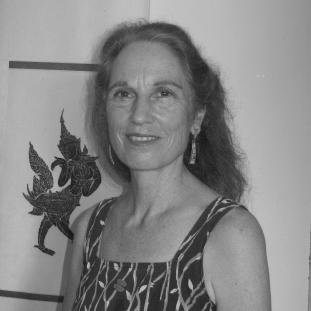Catherine Diamond

Interweaving Performance Cultures
Fellow 2013/14
Catherine Diamond is a professor and theatre director at Soochow University. Her current focus lies on environmental themes in Southeast Asian theatre. Previously researching Chinese theatre, she received a Fulbright fellowship to write about textual adaptation in the post-martial law theatre in Taiwan. Her research was published in Chinese as Actors are Madmen; Spectators are Fools: Taiwan Theatre 1988-98. She was the director of Phoenix Theatre, an English-language theatre in Taipei, and is currently the director/playwright of the Kinnari Ecological Theatre Project (KETEP) that produces new plays by combining Southeast Asian folk narratives with local environmental problems. She has written several works of fiction and poetry set in Taiwan, as well as short stories about dancers in Asia and the Middle East. She has just finished a novel set in the world of Spanish flamenco. As a flamenco dancer, she performs in Taipei, and she recently directed a dance-drama based on Lorca’s La Casa de Bernarda Alba performed by Taiwanese flamenco dancers.
Research Project
Formulating A Biocentric Theatre Aesthetic
I am investigating the possibility of a biocentric theatre aesthetic that would incorporate the evolving relationships between human and nonhuman life from the perspectives of different Asian and Western cultures. Theatre is an artificial cultural construct that often stands opposed to nature, and the representation of nature in a theatrical context has always been problematic. Traditional preindustrial theatres dealt with the problem through stylization and symbolism. Realistic theatre was more awkward in presentation but did include the destruction of nature in its social critique, such as in Ibsen’s Enemy of the People. Contemporary realistic dramas treat nature as a source for intellectual debate but without much insight into nature itself.
Contemporary work that more deeply explores nature-humanity relationships is often nonverbal performance, incorporating visual and choreographic arts. It performs with more immediacy than text-based plotted drama. Film also more easily accommodates ecological realism and is better able to represent the vast reach of nature.
However, textual drama can plumb cultural narratives and derive new perspectives from traditional knowledge. Scientific discoveries, providing new insights into the interconnectedness between human and nonhuman life, can inspire new forms of theatrical narrative. I wish to look into biomimetics as a source for new drama structures. A biocentric theatre would recalibrate religious hierarchies that ethically and spiritually separate the human and nonhuman. It would search for a new aesthetic that brings nature into the theatre and expands the nature of theatre.
Recommended Publications
-
Arons, W./May, T. (eds.) Readings in Performance and Ecology, New York: Palgrave Macmillan, 2012.
-
Thornber, K. L., Ecoambiguity: Environmental Crisis and East Asian Literature, Ann Arbor: University of Michigan, 2012.
-
Diamond, C., Communities of Imagination: Southeast Asian Contemporary Theatres, Honolulu: University of Hawai’i Press, 2012.
